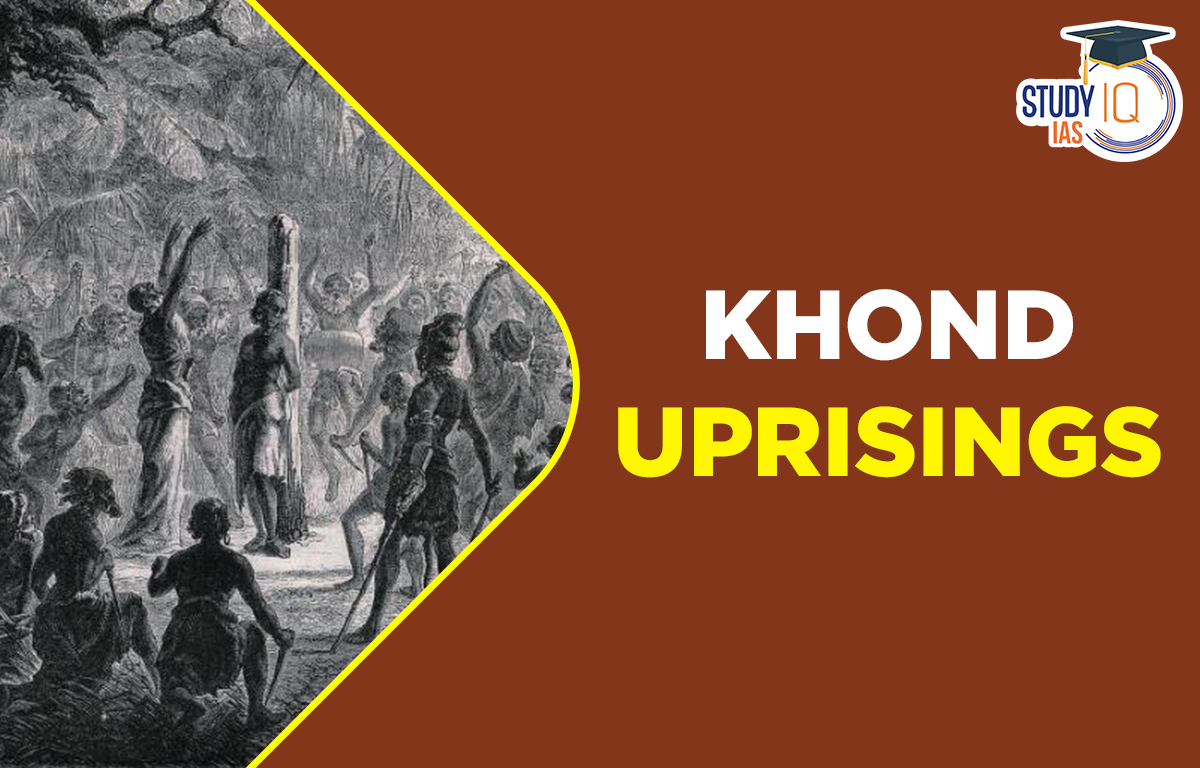Table of Contents
Khond Uprisings
The Khond Uprisings in Orissa took place in 1837 and 1856. The head of the Khonds was Chakra Bisoi. The Orissan Khonds played a key role in organizing the uprising against the British administration in 1857. Those who rebelled included tribes from Ghumsar, China ki Medi, Kalahandi, and Patna. Young Raja Chakra Bisnoi served as the movement’s leader. You will learn more about the Khond Uprisings (1837–1856) in this article, which will help you prepare for the UPSC Civil Service Exam.
Read More: Chuar Uprising
Khond Uprisings History
The Khonds of the mountainous regions from Odisha to the Andhra Pradesh districts of Srikakulam and Visakhapatnam rebelled against Company rule between 1837 and 1856. Young raja Chakra Bisoi led the Khonds in their fight against the abolition of human sacrifice, higher taxes, and the invasion of zamindars into their lands, which were supported by the Ghumsar, Kalahandi, and other tribes. The disappearance of Chakra Bisoi put a stop to the uprising.
Read More: Santhal Rebellion
Khond Uprisings Reasons
The British government’s decision to end the Mariah System, the imposition of additional taxes by the British government, and the influx of Zamindars and Moneylenders into tribal areas, which caused the tribals great suffering, were just a few of the many factors that contributed to the insurrection. The Khond Uprisings main concern was the outlawing of the “Mariah” practice.
It was a type of human sacrifice that was forbidden by the British government. Yet, this was not the only factor in Khond’s uprising. Further contributing reasons included the implementation of new taxes and the expansion of zamindars and moneylenders into traditional tribal territory. As a result, the Khonds were disenfranchised, oppressed, and their animosity towards British rule grew.
The Khonds battled the British with axes, hatchets, and bows and arrows, but their valour was unable to overcome British technological achievements, and their insurrection was put down violently. The Khonds engaged the Mariah Agency of the British government in combat with swords, bows, arrows, and Tangi, a form of war axe. Later, it was joined by the Savaras and other militia clans led by Radhakrishna Dandasena. Chakra Bisoi vanished in 1855. A later Khond rebellion in the Orissa region in 1914 was prompted by the belief that foreign dominance would end and that they may achieve autonomy.
Read More: Paharias Rebellion
Khond Uprisings and Khond people
An Indian tribal group known as the Khonds (also written Kondha, Kandha, and various variants) exists. They are separated into plain-dwelling Khonds and hill-dwelling Khonds for census purposes. Even though they frequently possess considerable sections of fertile land and all identify by clan, Khonds still engage in hunting, gathering, and slash-and-burn agriculture in the forests as a representation of their relationship with and ownership of the forest.
Khonds spoke the Kui and Kuvi languages, which are transcribed in the Odia script. The Khonds are adept land dwellers who are better able to adapt to a wooded setting. Nonetheless, due to development efforts in areas such as irrigation, plantations, education, health care, and other sectors, they are in many ways forced into the modern way of life. Strength and symmetry characterize their physical attributes. The heel of their feet is in line with the back of their thighs, and the color of their skin ranges from light bamboo to a deep copper shade.
Read More: Kol Rebellion
Khond Uprisings Issues
The outlawing of the “Mariah” practice was the fundamental cause of the Khond rebellion. The British government had outlawed the practice of human sacrifice, but that wasn’t the only factor in the Khond rebellion. New taxes and the invasion of Zamindars and moneylenders into traditional tribal lands were two more factors.
As a result, the Khonds were oppressed and denied their rights; as a result, they developed animosity towards the British authority. The Khonds fought the British with hatchets, axes, and bows, but their fervour and bravery were unable to contend with British technological advancement, and thus their uprising was put down by force.
Read More: Tribal Movements in India
Khond Uprisings UPSC
The Khond are an indigenous Indian community that predominately resides in the Srikakulam and Visakhapatnam regions of Orissa and Andhra Pradesh. This tribe lived throughout central India, from Tamil Nadu to Bengal. These are the main tribal clans in Orissa. In Orissa, the Khond Rebellion took place between 1846 and 1855. The head of the Khonds was Chakra Bisoi. The Orissan Khonds played a key role in organising the uprising against the British administration in 1857. For the purpose of preparing for the UPSC Exam, this page contains all the information.
Read More: Reform Movements by Parsi


 Nagari Pracharini Sabha Revival: Backgro...
Nagari Pracharini Sabha Revival: Backgro...
 Ryotwari System in India, Features, Impa...
Ryotwari System in India, Features, Impa...
 Battle of Plassey, History, Causes, Impa...
Battle of Plassey, History, Causes, Impa...





















